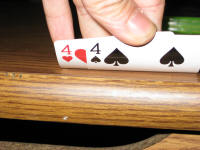Playing Small Pocket Pairs Preflop in No Limit Hold'em
 It is pretty straightforward to play small pocket pairs preflop, but many players tend to overplay small pairs and get themselves into big trouble. This page is going to analyze the preflop play of small pocket pairs, and will take into account factors such as position, chip stacks, and your opponents' tendencies.
It is pretty straightforward to play small pocket pairs preflop, but many players tend to overplay small pairs and get themselves into big trouble. This page is going to analyze the preflop play of small pocket pairs, and will take into account factors such as position, chip stacks, and your opponents' tendencies.
For this article, we consider pocket twos, pocket threes, pocket fours, pocket fives, and pocket sixes as "small pairs". Sevens through Jacks are medium pairs, and Queens through Aces are big pairs. Keep in mind that our strategy is designed for 9-handed NL Hold'em tables, and we use a $1/$2 table for examples.
Short Stack in Early Position
If you have a small pocket pair in early position with a short stack (any stack with less than twenty-five big blinds) you should usually fold. There are too many players behind you for you to make a standard raise, and calling is out of the question because there is a good chance someone will raise behind you and you will lose control of the pot.
If you are truly desperate (your stack is ten big blinds or less) you can go all-in here, because a small pair is a pretty good hand for getting all-in preflop. We recommend you fold though and find a better spot later.
Short Stack in Mid Position
Middle position is a little bit better than early position, but you still are in a tough spot because of your stack size. If there are a couple limpers in front of you, you can call and hope to see a cheap flop. I would only call if I had 20-25 big blinds though - anything less than that and I would either fold or go all in.
If the preflop action folds to you, you should make a raise to $8 and try to steal the pot. If you are called, you still have a good shot at taking the pot on the flop, but if your opponent shows aggression on the flop and you didn't hit a set, I would release the hand.
If you are extremely short stacked and the preflop action folds to you, you can either go all in or fold. A standard raise doesn't make much sense, because your stack will be too small to even make a pot-sized bet on the flop.
Short Stack in Late Position
You can play late position with a small pocket pair basically the same as you would play mid position with a small pocket pair. Call if there are limpers, make a standard raise if it is folded to you, or go all-in if you are extremely low. You can even limp in if no one has limped in front of you to help disguise your hand.
Average-Big Stack in Early Position
Anyone with a stack of over fifty big blinds can play small pocket pairs the same from early position, middle position, and late position. In early position you should make a standard raise to $8, as it disguises your hand and will encourage opponents to think you have two big cards.
If you are re-raised by another player to $20 or $25, you can make the call (especially if there are other players in the pot, or if the stacks are very deep). If you happen to make a set you will probably win a massive pot, so it is worth making the call preflop.
Average-Big Stack in Mid Position
When you are in middle position with a small pocket pair you need to be especially conscious of other players' stack sizes. If a short stack makes a raise in front of you, throw your hand away because even if you do hit your set you won't win much of a pot. Also, it will be tough to play the flop if you miss your set, because the short stack will almost certainly bet the rest of his/her chips on the flop, leaving you with a tough decision.
If the same situation comes up but the raiser has an average or large stack, you have more options. In this case you can either fold (if you don't want to play the hand) or call the raise and look to hit a set on the flop. Since the raiser has a decent chip stack, it is a smart play to spend a few chips for the chance to win a huge pot.
Average-Big Stack in Late Position
When you have a small pocket pair in late position you should play very similarly to having a small pocket pair in mid position. If there are limpers in front of you feel free to call the raise and try to make a set. If everyone has folded to you, go ahead and raise it up to steal the pot. If someone has raised in front of you, only call if they have a good sized chip stack and the raise wasn't too big.
Now that you know how to play small pocket pairs preflop, learn how to play small pocket pairs postflop.
